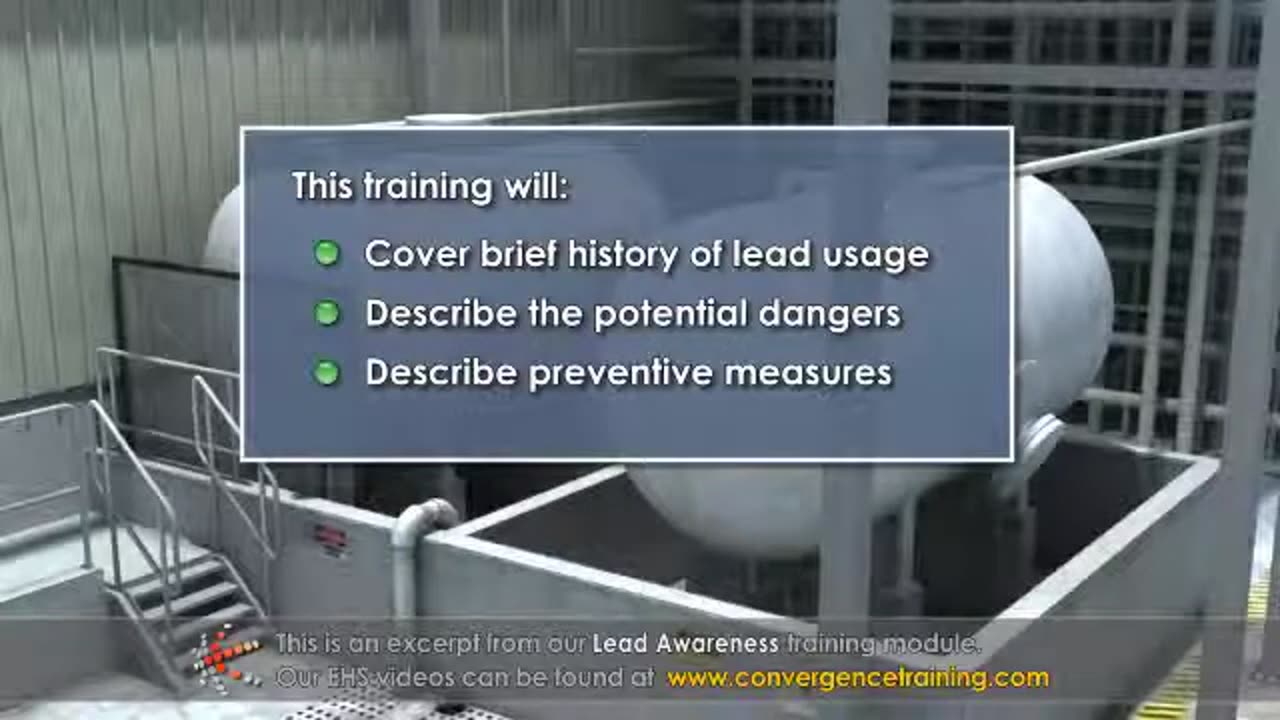Premium Only Content

Lead Awareness Training
Lead Awareness Training is designed to educate employees on the hazards of lead exposure, safe work practices, and regulatory compliance. This training is particularly relevant for industries such as construction, manufacturing, painting, and battery recycling. The training aligns with OSHA's **Lead Standard (29 CFR 1910.1025 and 29 CFR 1926.62)** to protect workers from lead-related health risks.
---
### **Lead Awareness Training Outline**
#### **1. Introduction to Lead**
- **What is lead?**
- A heavy metal used in construction, batteries, paints, soldering, and other industries.
- Common sources of occupational lead exposure:
- Lead-based paints.
- Cutting, welding, or sanding materials containing lead.
- Lead dust and fumes.
- Importance of lead awareness training and regulatory requirements.
---
#### **2. Health Effects of Lead Exposure**
- **Routes of exposure:**
- Inhalation of lead dust or fumes.
- Ingestion via contaminated hands, food, or drinks.
- **Short-term effects (acute exposure):**
- Abdominal pain, nausea, fatigue, irritability.
- **Long-term effects (chronic exposure):**
- Damage to the nervous system, kidneys, and reproductive system.
- Lead poisoning symptoms (e.g., memory loss, mood changes).
- Impact on children and pregnant women due to lead's developmental toxicity.
---
#### **3. OSHA Lead Standards**
- Permissible Exposure Limit (PEL): 50 µg/m³ averaged over an 8-hour workday.
- Action Level (AL): 30 µg/m³ for triggering additional monitoring and protection measures.
- Blood lead level (BLL) monitoring:
- Medical surveillance required for workers with exposure above the AL.
- Removal from lead work if BLL exceeds OSHA limits.
---
#### **4. Lead Exposure Control Methods**
- **Engineering controls:**
- Local exhaust ventilation (LEV) systems.
- Substituting lead-containing materials when possible.
- **Administrative controls:**
- Job rotation to limit exposure duration.
- Posting warning signs in lead hazard areas.
- **Personal protective equipment (PPE):**
- Respirators, gloves, coveralls, and safety goggles.
- Proper donning and doffing procedures to avoid contamination.
---
#### **5. Housekeeping and Hygiene Practices**
- Importance of maintaining clean workspaces:
- Wet cleaning or vacuuming with HEPA filters instead of dry sweeping.
- Hygiene measures:
- Washing hands and face before eating, drinking, or smoking.
- Changing out of work clothes before leaving the site.
- Designated areas for eating and drinking away from lead exposure zones.
---
#### **6. Lead Monitoring and Medical Surveillance**
- Air monitoring to measure workplace lead levels.
- Requirements for periodic blood lead testing:
- Frequency based on exposure levels and test results.
- Employer-provided medical surveillance for employees exceeding AL.
- Recordkeeping for exposure and medical surveillance.
---
#### **7. Recognizing Lead Hazards**
- Identifying tasks and materials that may contain lead.
- Visual signs of lead hazards (e.g., chipping or deteriorating lead-based paint).
- Reviewing and interpreting Safety Data Sheets (SDS) for lead-containing materials.
---
#### **8. Emergency Response Procedures**
- Immediate actions for lead exposure incidents.
- Proper disposal of lead-contaminated materials.
- Reporting exposure concerns and accidents to supervisors.
---
#### **9. Employer and Employee Responsibilities**
- **Employer duties:**
- Providing hazard communication, training, and PPE.
- Conducting exposure monitoring and medical surveillance.
- Ensuring compliance with OSHA's lead standards.
- **Employee duties:**
- Following safety procedures and using PPE correctly.
- Reporting unsafe conditions or exposure incidents.
- Participating in training and medical surveillance programs.
---
#### **10. Practical Exercises and Scenarios**
- Proper use of PPE (respirators, gloves, coveralls).
- Simulated lead hazard identification and control exercises.
- Reviewing workplace-specific lead exposure scenarios and safe practices.
---
#### **11. Quiz and Certification**
- Administer a quiz to test understanding of the material.
- Provide certificates to employees who complete the training successfully.
---
Would you like assistance tailoring this training for your industry or creating custom training materials?
-
 1:59:13
1:59:13
Steven Crowder
3 hours ago🔴 Trump is Time's Person of the Year & The Deep State Fails at Smearing Pete Hegseth
292K128 -
 LIVE
LIVE
The Shannon Joy Show
5 hours ago🔥🔥LIVE Exclusive With James Lindsay! Beware The WOKE RIGHT - A Marxist Counter Movement To Woke Left🔥
327 watching -
 LIVE
LIVE
The Nima Yamini Show
2 hours agoWill Germany Take Another 1 Million Syrians in 2025? Join the podcast with Miró
109 watching -
 34:38
34:38
Rethinking the Dollar
1 hour agoThe Melt Up 2025 Will Be Jaw Dropping | Morning Check-In
8.09K2 -
 1:14:23
1:14:23
Graham Allen
4 hours agoIran Drones Enter The US!! Is This WWIII?! + Trump Named MAN OF THE YEAR!
97K99 -
 LIVE
LIVE
LFA TV
15 hours agoTAKING OUT THE TRASH! | LIVE FROM AMERICA 12.12.24 11am EST
4,825 watching -
 11:34
11:34
The Dana Show with Dana Loesch
2 hours agoDana Loesch Reacts To Google's New Woke Christmas Ad
9.83K7 -
 LIVE
LIVE
hambinooo
3 hours agoBRAND NEW AWESOME FPS GAME
391 watching -
 2:59:08
2:59:08
Wendy Bell Radio
7 hours agoThe Rats Are Scrambling
116K126 -
 34:55
34:55
BonginoReport
6 hours agoIt's Official: We're Funding the Taliban (Ep.103) - 12/12/2024
91.1K127